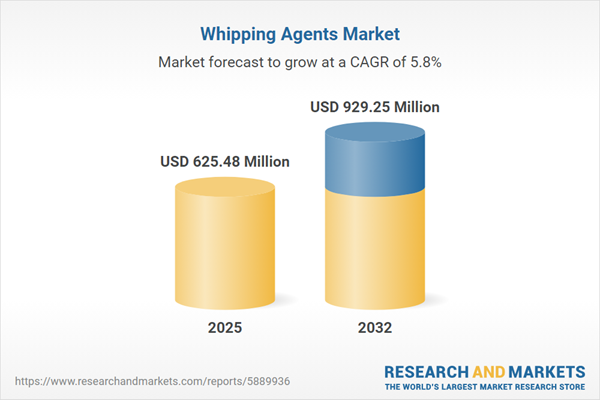Speak directly to the analyst to clarify any post sales queries you may have.
The whipping agents market is experiencing significant shifts as ingredient standards tighten and global regulations evolve. Senior executives must embrace adaptive innovation and enhanced operational strategies to ensure competitiveness and support ongoing growth.
Market Snapshot: Whipping Agents Market Overview
The global whipping agents market continues to expand, driven by consistent demand from food and beverage manufacturers. Companies are advancing their product portfolios to offer improved texture, superior foam stability, and better shelf presence. Market participants are increasing investment specifically in bakery, dairy, and beverage segments, reflecting rising consumer preference for both clean-label ingredients and premium formulations. Technology adoption—including updated ingredient science and digital operational tools—is accelerating alignment with new consumer and regulatory expectations related to quality, safety, and transparency. These developments enable businesses to optimize operations and respond proactively to changing market needs.
Scope & Segmentation in the Whipping Agents Market
This report delivers actionable segmentation and strategy insights to support executive leadership in managing emerging regulations, investment focus, and ambitious growth objectives across the whipping agents market. Market segmentation is structured as follows:
- Type: Covers aerosol and non-aerosol whipping agents, addressing their specific efficiencies and fit for both large-scale industrial and specialty manufacturing requirements.
- Form: Examines liquid and powder whipping agents, with analysis of logistics, storage efficiency, and ease of integration into production cycles.
- Application: Details utilization across bakery, dairy, beverage, and confectionery markets, identifying leading innovation zones and emerging expansion opportunities.
- Distribution Channel: Reviews direct and indirect paths to end-users, including food service operators, supermarket and convenience sectors, online platforms, and direct-to-consumer modalities, with commentary on their influence over go-to-market strategies.
- Geography: Explores trends and regulatory factors in the Americas, EMEA, and Asia-Pacific regions, with a focus on consumption drivers and compliance requirements imposed by local authorities.
- Key Companies: Profiles principal manufacturing leaders, including Cargill, International Flavors & Fragrances, Kerry Group, Tate & Lyle, Ingredion, Puratos, Palsgaard, Koninklijke DSM, Stern-Wywiol Gruppe, and Döhler, highlighting formulation expertise and established quality management practices.
Key Takeaways for Senior Decision-Makers
- Clean-label innovation continues to be prioritized, with companies introducing new fiber blends and adopting sustainable packaging solutions to stay in step with evolving compliance mandates.
- Introduction of advanced processing techniques, such as droplet engineering and encapsulation, is helping to achieve consistent product performance and extend shelf life, especially in bakery and dairy verticals.
- Acceleration of digital sales channels is prompting investments in more agile and responsive supply chains, which enhance manufacturers’ ability to navigate retail shifts and ensure continuous operations.
- Regional initiatives are being fine-tuned in response to specific market requirements—from technology integrations improving North American efficiencies to stricter labeling in EMEA and intensified retail expansion across Asia-Pacific.
- Greater collaboration between commercial and R&D teams is expediting innovation pipelines and strengthening relationships with procurement professionals in key buyer organizations.
Tariff Impact: Navigating Cost and Supply Chain Shifts
Recent adjustments to U.S. tariffs are increasing costs for aerosol-based whipping agents and associated stabilizers. In response, major producers are favoring local sourcing, reformulating products with alternative ingredients, and rigorously monitoring compliance. Strategies such as shifting supply chains domestically and utilizing digital regulatory monitoring are aimed at maintaining product availability and minimizing disruptions caused by trade changes.
Methodology & Data Sources
This analysis integrates direct interviews with leaders in product development, procurement, and R&D across the food production landscape. Supplementary insights are obtained from surveys of food service operators and validation is provided via review of sector documentation and regulatory compliance records, ensuring actionable guidance for leadership teams.
Why This Whipping Agents Market Report Matters
- Offers executive-focused intelligence on current industry shifts and the regulatory landscape, facilitating global and regional strategy refinement.
- Equips leadership with insights to strengthen procurement and supply chain management, mitigate operational risks, and drive adherence to evolving standards.
- Supports innovation efforts and development of strong supplier partnerships, enhancing strategic responsiveness amid sector change.
Conclusion
Success in the whipping agents market depends on sustained innovation and operational flexibility. Senior decision-makers who prioritize adaptability and compliance are best positioned to capture growth and ensure long-term market resilience.
Additional Product Information:
- Purchase of this report includes 1 year online access with quarterly updates.
- This report can be updated on request. Please contact our Customer Experience team using the Ask a Question widget on our website.
Table of Contents
3. Executive Summary
4. Market Overview
7. Cumulative Impact of Artificial Intelligence 2025
Companies Mentioned
The companies profiled in this Whipping Agents market report include:- Cargill, Incorporated
- International Flavors & Fragrances Inc.
- Kerry Group PLC
- Tate & Lyle PLC
- Ingredion Incorporated
- Puratos NV
- Palsgaard A/S
- Koninklijke DSM N.V.
- Stern-Wywiol Gruppe GmbH & Co. KG
- Döhler GmbH
Table Information
| Report Attribute | Details |
|---|---|
| No. of Pages | 197 |
| Published | November 2025 |
| Forecast Period | 2025 - 2032 |
| Estimated Market Value ( USD | $ 625.48 Million |
| Forecasted Market Value ( USD | $ 929.25 Million |
| Compound Annual Growth Rate | 5.8% |
| Regions Covered | Global |
| No. of Companies Mentioned | 11 |









